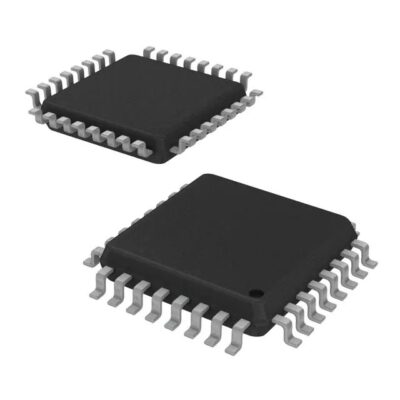TUSB2046BIVFR
Part Number: TUSB2046BIVFR
Manufacturer: Texas Instruments
Description: USB Interface IC 4-Port Full-Speed Hub
Shipped from: Shenzhen/HK Warehouse
Stock Available: Check with us
ICRFQ.com - Electronic Components Distributor in China Since 2003

Part Number: TUSB2046BIVFR
Manufacturer: Texas Instruments
Description: USB Interface IC 4-Port Full-Speed Hub
Shipped from: Shenzhen/HK Warehouse
Stock Available: Check with us
| Datasheet | |
|---|---|
| Category | Integrated Circuits (ICs) |
| Family | Interface – Controllers |
| Manufacturer | Texas Instruments |
| Series | – |
| Packaging | Tape & Reel (TR) |
| Part Status | Last Time Buy |
| Protocol | USB |
| Function | Hub Controller |
| Interface | USB |
| Standards | USB 1.0 |
| Voltage – Supply | 3 V ~ 3.6 V |
| Current – Supply | 40mA |
| Operating Temperature | -40°C ~ 85°C |
| Package / Case | 32-LQFP |
| Supplier Device Package | 32-LQFP (7×7) |
The TUSB2046B is a hub device conforming to the USB 2.0 full-speed specification and has one upstream and four downstream ports. This schematic checklist describes each device pin and its default setting. You can use this data to double-check the TUSB2046Bs’ connections on a system diagram. This article is a supplementary resource for the system-level design of generic applications. Please refer to the TUSB2046B datasheet, TUSB2046B EVM User’s Guide, and other papers to fully grasp the device’s capabilities.
The TUSB2046x complies with the USB full-speed hub specification and operates on 3.3 volts, using CMOS technology to provide one upstream port and four downstream ports. This gadget doesn’t need custom firmware because it uses a digital state machine instead of a microcontroller. The ASIC has upstream and downstream USB transceivers that comply with all standards. The downstream ports are compatible with both high- and low-speed devices since their slew rate can be adjusted automatically. It is possible to switch between bus-powered and self-powered modes by setting the BUSPWR pin in a particular way.
Power Control for USB Devices The PWRON pin’s value determines how much power is supplied to the downstream ports; hence, an external power management device like the TPS2044 is needed to regulate this supply. When the power management device detects an overcurrent condition, the OVRCUR pin of the TUSB2046x is driven low. All PWRON outputs will toggle together if GANGED is high, and all ports will go into power-off mode if any OVRCUR is active. When GANGED is off, each port’s PWRON output and OVRCUR input are active. Overcurrent protection for all downstream ports is mandatory for bus-powered and self-powered hubs.
Both individual-port management (on a per-port basis) and ganged-port management (on numerous ports at once) are viable methods of security (multiple-port foundation). In the event of an overcurrent issue, the USB host only powers down the affected port, making the USB system more robust. However, individual-port management necessitates power-management devices for each downstream port. The ganged design uses fewer power-management components, reducing system costs, but if one of the downstream ports has an overcurrent issue, the USB host will shut down all of the ganged ports.
The BUSPWR and EEDATA/GANGED inputs activate the TUSB2046x’s four power management modes: bus-powered hub with individual port power management or ganged-port power management, and self-powered hub with the same two options. The TUSB2036 (2/3-port), TUSB2046x (5-port), and TUSB2077 (7-port) hubs, as well as the power-management devices required to construct a fully USB specification-compliant system, are all available from TI as part of the company’s comprehensive hub solution.
Using an External Serial EEPROM to Store Vendor and Item Information The EXTMEM pin toggles the EEPROM interface on and off. If the EXTMEM pin is set to high, the product ID (PID) shown during enumeration will be that of the hub’s universal USB host controller. Because of this setting, pin 5 is not used, and pin 6 is the GANGED input pin. The EXTMEM pin must be set to 0 (low) if unique product ID (PID) and vendor ID (VID) labels are needed. In this setup, pins 5 and 6 (labeled EECLK and EEDATA, respectively) serve as the EEPROM interface.
The re-programmable VID and PID are kept in an EEPROM, such as an SGS Thompson M93C46 or a compatible device. The TUSB2046x has an inbuilt pulldown (100 A) on the EECLK and EEDATA while the EEPROM interface is active (EXTMEM = 0). When the EEPROM interface is turned off (EXTMEM = 1), the internal pulldowns are also deactivated.
USB’s significant benefit is the capacity to link 127 functions organized across 6 logical layers (tiers) to a single PC. One more perk of USB is that it uses a common 4-wire cable to transmit data and supply power to all attached devices. There are two different power setups, bus-powered and self-powered. During power-up, a maximum of 100 mA can be consumed from the USB 5-V line. When operating in bus-powered mode, a hub can drain up to 500 mA from the USB cable’s 5-V line.
Unless it is the sole hub linked to the PC and no high-powered functions are attached downstream, a bus-powered hub must always be connected to a self-powered hub. Each downstream port can receive up to 500 mA of power while the hub operates in its self-powered mode, which occurs when an external power source is attached to the unit. High-powered functions may take a maximum of 500 mA from each downstream port and may only be linked downstream to self-powered hubs. USB specifies that in bus-powered mode, each downstream port can supply up to 100 mA of current, while in self-powered mode, each downstream port can supply up to 500 mA.
Contact ICRFQ, your one-stop shop for purchasing electronic components in China, if you need further information or wish to place an order for the TUSB2046BIVFR. We will work hard to ensure you get the best possible products at affordable prices.
WhatsApp us